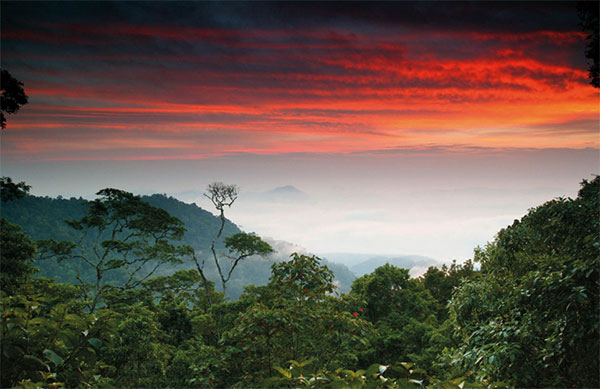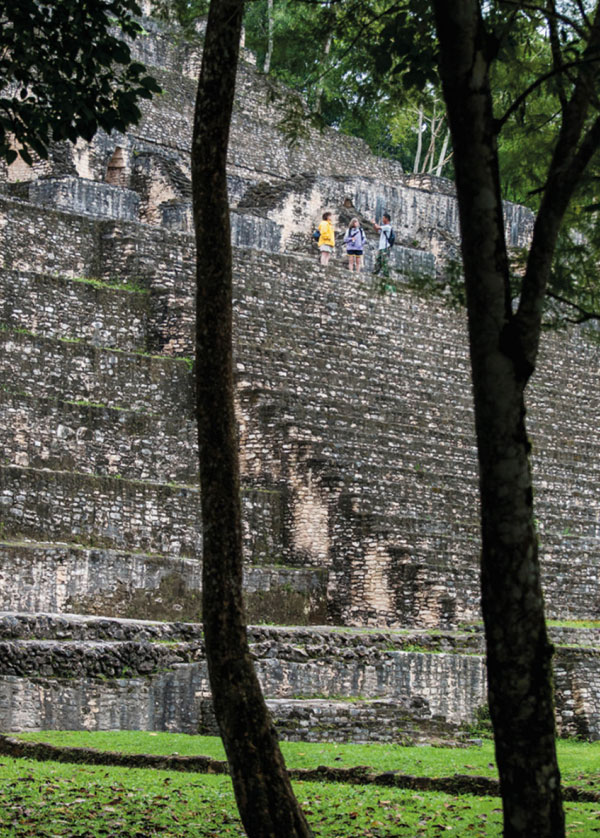THE KUNA YALA
Spread out across 49 communities in the Comarca, there are an estimated 50,000 Kuna people, also known as Guna, living in much in the same way they have for centuries. During the time of conquest, many were living in what is today known as the Darién, but fighting with the Catio people and Spanish forced them to the islands. Within the Comarca, each community has its own political organization, led by a political and spiritual leader called a saila, who sings the legends and laws of the Kuna people. He is accompanied by one or two voceros, who help interpret the songs. Kuna families are traditionally matrilineal, as the groom becomes a part of the bride’s family and takes her last name.
In Panama City, the Kuna, who speak a Chibchan language, stand out as they wander through Casco Viejo, wearing their brightly colored headscarves, gold septum rings, and arms and legs covered with beaded bracelets. The Kuna are most famous for their colorful molas, a textile art form made of appliqué and reverse appliqué techniques, which are worn daily by most Kuna women. Trade of the molas, along with that of lobster and coconuts, has allowed the Kuna to function independently while other Indigenous groups in Panama have had much difficulty in maintaining their culture.
The Darién Province
On its journey between Alaska and southern Chile, the Pan-American highway makes one break, which is in Panama’s Darién Province, bordering Colombia. The Darién Gap, as it is called, is composed of nearly a million hectares (2.4 million acres) of virgin rainforest which teems with diverse flora and fauna, all within the boundaries of the Darién National Park, Panama’s largest protected area and a Unesco Biosphere Reserve. While much of the interior is rugged and difficult to reach, the coastlines offer some opportunities for travelers.

Dawn at Cerro Pirre peak in Darién National Park.
Alamy
Western Darién
Before the Pan-American Highway ends near the town of Metetí, the owners of the more established birding lodges (Canopy Tower and Canopy Lodge) operate Canopy Camp Darien (www.canopytower.com/canopy-camp). This upscale, all-inclusive tent camp borders the edge of the 26,000-hectare (65,000-acre) Serrania Filo del Tallo Hydrological Reserve, which offers opportunities to see harpy eagles and other rare species of birds and mammals.
Darién National Park
Central America’s largest of its kind, Darién National Park ¤ [map] is a Unesco World Biosphere Reserve, covers 575,000 hectares (1.4 million acres). Rarely visited, it is rich with biodiversity, ranging from coastal lagoons to untouched rainforest where jaguars and ocelots have been allowed to flourish. It’s one of the top ten bird-watching destinations on earth, where rare species like red-throated caracaras and golden-headed quetzals are seen with ease.
Without a guide, the park is inaccessible. Apart from Ancon Expeditions (www.anconexpeditions.com), few guides are equipped to handle trips to either of the access points at Cerro Pirre peak on the north side of the park, or the Cana Field Station toward the southeast. Amenities are non-existent other than simple bunks at the ranger stations. From either entrance point, trails lead deep into the interior of the park and some rivers can be traversed by dugout canoe.
The South Coast
Most who come to Piñas Bay do so for one reason: sport fishing. Within 20km (12 miles) of the shore, hundreds of fishing records have been broken, a fame that attracts an elite clientele. They stay at the surprisingly simple Tropic Star Lodge (www.tropicstar.com), which was founded as a private fishing retreat for a Texas oil tycoon. Billfish like black marlin and sailfish are caught from a fleet of 9.4-meter (31ft) Bertram boats that ply the waters off Zane Grey reef.

Tourists exploring the Mayan temple at Caracol, Belize.
Getty Images
OVERVIEW
Accommodations
Central America offers accommodations of all types, from seedy and ramshackle to ultra-luxurious. Very remote destinations tend to have options on the extreme ends of the spectrum, including luxury hotels or eco lodges, along with sketchy sailor hangouts where you won’t want to take the kids. In most places you will be expected to drop toilet paper in a waste basket, not the toilet itself, because the plumbing can’t cope. Major cities, particularly the capitals, will tend to have the greatest variety of accommodations, from hostels to luxury chain hotels catering to business travelers. Quality in most countries is improving, and nearly all hotels will offer guests wireless internet – although some business hotels will charge a fee.
Climate and when to go
In Central America, temperature depends greatly on altitude above sea level, and temperate climates can be found among mountain landscapes away from the coasts. Hot, tropical temperatures tend to prevail throughout the year in the lowlands and islands. There’s usually still plenty of sunshine during the wetter months, although humidity will be at its highest. Most visitors tend to plan their travels around the dry season in the region, which is roughly from November through May. The rainy season lasts from around April to December, while hurricanes typically appear in the region from September to November, or in June and July in the Yucatan. Unfortunately, much of Central America is feeling the impact of climate change with more cases of extreme weather conditions.
Crime and safety
The crime rate is generally high in Central America, but risks can be minimized by taking a few basic precautions:
Expensive jewelry should not be worn and large amounts of money and valuable watches should be kept out of sight.
Ignore offers of help by passers-by and clean up in a safe place.
Wear a money belt when traveling to keep your belongings safe.
Keep an eye on your possessions at all times, especially on beaches, and use hotel safes whenever possible (but take a verified list of what you have deposited).
Do not leave valuables in cars.
Avoid walking alone and in deserted areas after dark. Traveling alone after dusk is not advisable.
Never carry packages for other people without checking the contents.
Radio taxis are safer than curbside taxis after dark.
Don’t hitchhike. For journeys overland choose well-known and established bus companies when possible.
Carry your passport at all times – and leave a photocopy in your hotel.
For specific inquiries, contact your embassy. The US State Department and the British Foreign Office both publish detailed information on all Central American countries and offer advice to travelers. Their websites are, respectively:
US: http://travel.state.gov
UK: www.fco.gov.uk